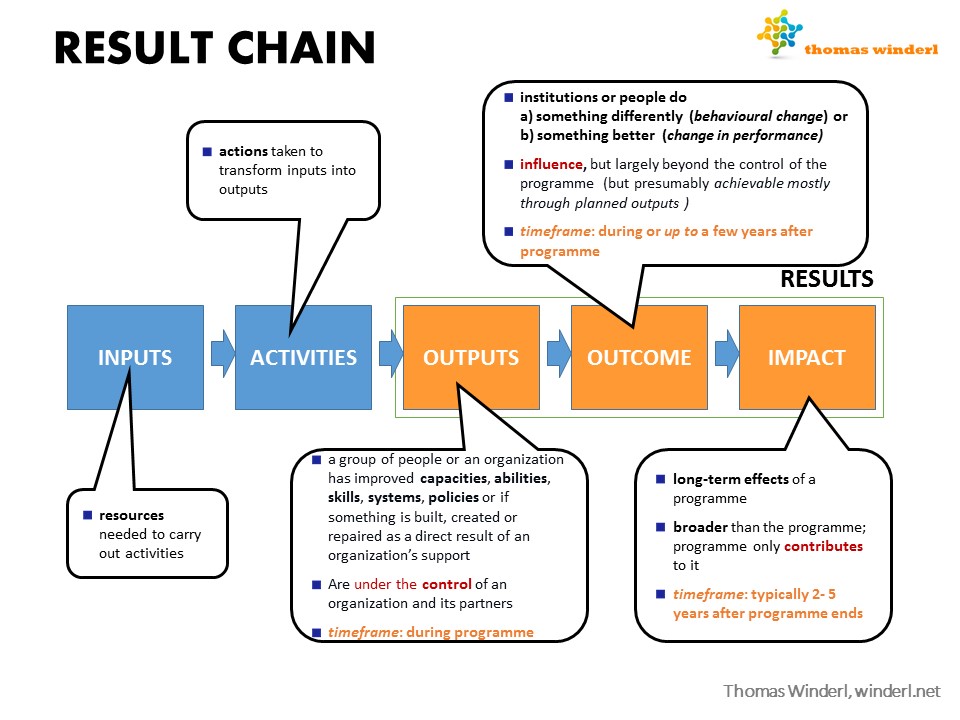Monitoring and Evaluation are about measuring and tracking results. That is why it is important to understand what results are, and how to distinguish between different levels of the results chain.
In general, a “result” is something that happens or exists because of something else that has happened:
- the results of a football game
- the final value of a mathematical calculation, or
- the outcomes of an election.
In development and governance, we use a more nuanced understanding of different types of ‘results’: the so-called result chain.
The results chain distinguished between five logically connected elements:
- inputs
- activities
- outputs
- outcomes, and
- impact
A REAL-LIFE EXAMPLE
It’s not complicated – and we use this logic all the time. Let’s take a simple example:
I want to do something about living a healthier life. This is the desired impact. To do that, I want to reduce my weight. This is my planned outcome. To reduce my overall weight, I plan on eating more vegetables and exercising regularly. These are my planned outputs. Eating healthier requires more conscious shopping habits. More exercise requires me to go running or join a gym. These are some of my planned activities. These activities require some extra time and money. These are the inputs.
ELEMENTS OF A RESULTS CHAIN
Let us look more in detail at a typical results chain of a development or government programme, policy or service. This time we start at the lower end of the result chain and work our way up:

INPUTS
Any programme, policy or service requires resources of some kind. We call these resources inputs.
For example: to put together this course, it took me time to record this video; you need an internet connection and a computer to watch it.
Typically, inputs refer to money, staff time, materials and equipment, transport costs, infrastructure, etc.
ACTIVITY
These inputs are required to carry out a number of activities.
For example: you watch videos of this lesson; you do a quiz; you do some additional reading; you watch the next videos; etc.
So: Activities are actions taken that use inputs to produce higher-level results – ‘outputs.’
Typical activities in governance and development are the drafting of a policy document for a ministry, the organization of a media outreach campaign, the training of midwives in a new approach, etc.
OUTPUT
At the next level, outputs are typically the result of several completed activities.
For example: after reading this blog post, you have the knowledge to critically review and design your own results chain.
In development and governance, an output is delivered if a group of people or an organization has improved capacities, abilities, skills, systems, or policies or if something is created, built or repaired.
Outputs are the direct result of a set of activities delivered during the implementation of a programme, a policy or a service. Outputs are different from the next level of results – outcomes – because you largely have control over delivering outputs.
That means that if we – and our partners – have the resources and the time to deliver a certain output, we can largely guarantee that the output will be delivered.
That also means, that in turn, we are fully responsible for delivering an output.
Typical outputs are a draft policy document for a ministry, a media outreach campaign, improved skills for, etc.
OUTCOME
Now, this is very different from the next level of results: An outcome is something we hope to achieve as a result of what we do.
In development and governance, an outcome implies that institutions or people do
- a) something different (behavioural change) or
- b) something better (change in performance)
The difference between an outcome is that – unlike outputs which we largely control – we can only influence the achievement of an outcome, but it ultimately goes beyond our control.
Typical outcomes are a parliament passing a new law, people changing their behaviour because of a media campaign, midwifes that apply new skills in their daily routine, etc.
Outcomes are typically achieved at the end or even after a programme, policy or service has been implemented.
IMPACT
Finally, outcomes should contribute to a broader impact.
An impact is the long-term effect of programmes, policies or services. It implies a detectable improvement in people’s lives.
Impact typically relates to positive economic, social, cultural, institutional, environmental, technologicalchanges in the lives of a targeted population. An impact is often related to broad national goals or international aspirations like the Sustainable Development Goals. Impact is typically much broader than a programme, policy or service. And: an impact is typically detectable only after a few months or even years.
What about ‘results’?
So: Which of these elements of a result chain do we consider ‘results’?
We usually define ‘results’ – in the context of governance and development – as the top three elements of the result chain: outputs, outcomes and impact. And most importantly, results are not inputs or activities.
What to learn more about how to the results chain works? Check out our detailed video course on Practical Results Based Management on Udemy.